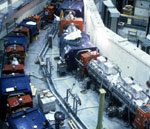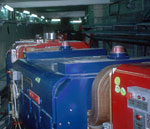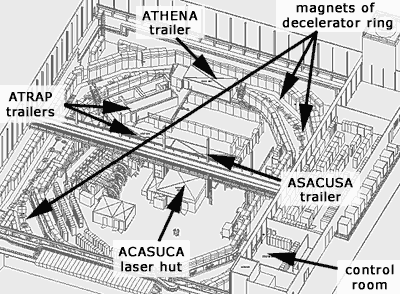|
 CERN's
Antiproton Collector (AC) and CERN's Antiproton Accumulator
(AA).
CERN's
Antiproton Collector (AC) and CERN's Antiproton Accumulator
(AA).
photo: CERN
|

The
Antiproton Decelerator (AD) is the only facility of its kind
anywhere in the world. It is sort of an antimatter factory,
uniquely capable of trapping antiprotons and slowing them
to speeds where scientists can study them.
The researchers working in the AD are looking for differences
in how matter and antimatter behave. Antimatter is something
like a mirror image of matter. Researchers think that if
there are differences between them, they might help us understand
why matter won out against antimatter just after the Big
Bang.
 The
diagonal pipe is part of the stochastic cooling system,
which takes measurements and transports them to the
other side of the ring before the antiprotons arrive.
The
diagonal pipe is part of the stochastic cooling system,
which takes measurements and transports them to the
other side of the ring before the antiprotons arrive.
|
There are
three experiments underway in
the AD
, and each of them will trap antimatter, see how
it behaves, and compare this behavior the behavior of matter.
Two of the experiments, ATHENA and ATRAP, will compare properties
of hydrogen and antihydrogen. ASACUSA will create "atomcules,"
hybrid atoms containing a helium nucleus and orbited by an
electron and an antiproton.
How
it works
The
AD is a relatively small ring (only several hundred meters
in circumference, compared with 27 km in the LHC) used to
slow down and focus a beam of antiprotons as they come speeding
out of the Proton Synchrotron. The antiprotons arrive at
the AD like a blast from a garden hose, scattered in various
directions and moving at different speeds. The first task
of the machine is to focus the antiprotons into a tidy,
controllable beam. This is done with the help of a method
called "stochastic cooling." With stochastic cooling,
measurements of the beam are taken on one side of the ring,
and sent across the middle of the ring in time to make adjustments
to the AD before the beam comes around the bend from the
other side.
 The
antiproton pipe turning a corner. Blue dipole magnets
direct the beam, and red quadrupole magnets focus it.
The
antiproton pipe turning a corner. Blue dipole magnets
direct the beam, and red quadrupole magnets focus it.
|
Once the beam is refined enough, deceleration begins. This
is a somewhat complicated process because, as the beam slows
down, it has a tendency to expand. Physicists measure energy
in units called electron volts (eV) and momentum in electron
volts divided by the speed of light (eV/c). Because one eV
is so small, scientists usually use giga-electron volts (GeV),
which equals one billion electron volts. Scientists decelerate
the beam in several steps, interspersing it with more cooling.
First, the antiprotons are slowed from 3.57 GeV/c to 2 GeV/c
by using radio frequency electric fields. Red dipole magnets
(with two poles) keep the beam bent and flowing around the
ring. As the beam is being slowed, blue quadropole magnets
(with four poles) keep it focused. Stochastic cooling helps
to streamline the beam as it travels through the pipe. Once
it’s been slowed to 300 million eV/c, a second step begins,
called "electron cooling." A thick, cool cloud of
electrons travels in the same direction as the antiprotons,
cooling them further. The process is similar to mixing flows
of hot and cool water until they are lukewarm. It also helps
line up the antiprotons in the direction they’re moving.
When the beam has been slowed down to 100 million eV/c, the antiprotons
can be captured for the experiments. They are delivered in
bunches, at about one bunch per minute, with about 10 million
antiprotons per bunch. In order to conduct an experiment,
scientists need to capture about 10 million antiprotons.
 Inside
the AD.
Inside
the AD.
|
|